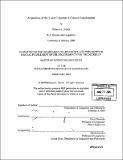| dc.contributor.advisor | David Pesetsky. | en_US |
| dc.contributor.author | Norris, Rebecca L. (Rebecca Lynn), 1977- | en_US |
| dc.contributor.other | Massachusetts Institute of Technology. Dept. of Linguistics and Philosophy. | en_US |
| dc.date.accessioned | 2009-01-30T18:38:16Z | |
| dc.date.available | 2009-01-30T18:38:16Z | |
| dc.date.copyright | 2003 | en_US |
| dc.date.issued | 2004 | en_US |
| dc.identifier.uri | http://dspace.mit.edu/handle/1721.1/28344 | en_US |
| dc.identifier.uri | http://hdl.handle.net/1721.1/28344 | |
| dc.description | Thesis (S.M.)--Massachusetts Institute of Technology, Dept. of Linguistics and Philosophy, February 2004. | en_US |
| dc.description | Includes bibliographical references (leaf 48). | en_US |
| dc.description.abstract | In order to discover how children acquire the T(ense) and C(omplementizer) system, finite and nonfinite embedded clauses produced by children in the CHILDES database were studied. It was discovered that young children often delete to in nonfinite embedded clauses, and that they use that in the C position of finite imbedded clauses far less often than adults do. By adapting Wexler's (1998) theory of optional infinitives to a Pesetsky and Torrego (2001, 2002) framework, I show that the facts about both finite and nonfinite embedded clauses are due to three conflicting constraints: a modified Unique Checking Constraint based on that in Wexler (1998), a conceptual constraint requiring both T and C to appear in every full clause, and a constraint which tells children to use phonological closeness to decide which goal to move when two goals are equally close to a probe. Children cannot avoid violation of at least one constraint, so they are required to violate as few as possible. This results in different possible derivations, each one of which produces results which are seen in child speech. | en_US |
| dc.description.statementofresponsibility | by Rebecca L. Norris. | en_US |
| dc.format.extent | 48 leaves | en_US |
| dc.language.iso | eng | en_US |
| dc.publisher | Massachusetts Institute of Technology | en_US |
| dc.rights | M.I.T. theses are protected by
copyright. They may be viewed from this source for any purpose, but
reproduction or distribution in any format is prohibited without written
permission. See provided URL for inquiries about permission. | en_US |
| dc.rights.uri | http://dspace.mit.edu/handle/1721.1/28344 | en_US |
| dc.rights.uri | http://dspace.mit.edu/handle/1721.1/7582 | en_US |
| dc.subject | Linguistics and Philosophy. | en_US |
| dc.title | Acquisition of the T and C system in clausal complements | en_US |
| dc.title.alternative | Acquisition of the tense and complementizer system in clausal complements | en_US |
| dc.type | Thesis | en_US |
| dc.description.degree | S.M. | en_US |
| dc.contributor.department | Massachusetts Institute of Technology. Department of Linguistics and Philosophy | |
| dc.identifier.oclc | 55704246 | en_US |

